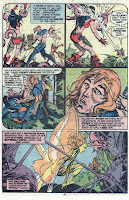Killraven: 'Amazing Adventures' No. 39
This is it !
It’s early Fall 1976 and the final issue of the 22-issue ‘War of the Worlds’ series, starring Killraven, is out and in the pages of ‘Amazing Adventures’ (November 1976).
The cover tells us it’s ‘The Final Glory’….is this the final battle, the ultimate showdown with the Martians ? Will Killraven and his crew engage in one last desperate struggle to overthrow Earth’s conquerors and make the planet free again ?
Nope…!
In fact, this last installment of the original Killraven saga is one of the lamest conclusions in the history of modern comics !
‘Mourning Prey’ has nothing to do with the Martian at all. Not only are there no Martians in this issue, but it’s pretty plain that Stan Lee and Archie Goodwin had no intention of commissioning a special concluding story arc. Killraven’s sales were bad, the series was being canceled, so they simply ran whatever story writer Don McGregor had in the queue.
‘Mourning Prey’ is McGregor’s writing at its worst: clumsy flashbacks, poetic, purple language, empty phrases designed to communicate Something Profound. Toss in the fact that the main adversary is a Butterfly Woman (?!) who’s mad at Killraven for slaughtering some purple caterpillars (?!), and you have the makings of a real underwhelming story………
As always, artist Craig Russell’s work is of good quality and struggles to express itself under McGregor’s verbiage.
So here it is in its entirety, the last issue of the ‘Killraven / War of the Worlds’ series from the mid-70s:





























































































